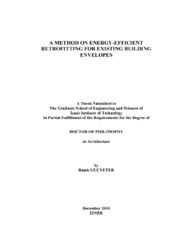Please use this identifier to cite or link to this item:
https://hdl.handle.net/11147/2923Full metadata record
| DC Field | Value | Language |
|---|---|---|
| dc.contributor.advisor | Günaydin, Hüsnü Murat | - |
| dc.contributor.author | Güçyeter, Başak | - |
| dc.date.accessioned | 2014-07-22T13:48:37Z | - |
| dc.date.available | 2014-07-22T13:48:37Z | - |
| dc.date.issued | 2010 | - |
| dc.identifier.uri | http://hdl.handle.net/11147/2923 | - |
| dc.description | Thesis (Doctoral)--İzmir Institute of Technology, Architecture, İzmir, 2010 | en_US |
| dc.description | Includes bibliographical references (leaves: 218-227) | en_US |
| dc.description | Text in English;Abstract: Turkish and English | en_US |
| dc.description | xviii, 227 leaves | en_US |
| dc.description.abstract | Starting in 1970s with the two major oil crises, conservation of non-renewable energy sources became an important concern. Buildings, which hold a large portion of energy consumed in the world, became subject to significant reductions through the energy consuming processes, especially for space heating and cooling energy consumption end uses. Strong initiatives are set in the world, promoting energy efficiency in buildings, both for new designs and existing building stock. However, energy-efficient improvement of existing building stock is a more challenging process for existing buildings; due to lack of energy conscious decisions, which were disregarded during design process. Energy-efficient retrofitting thus becomes an important focus of the research areas that aim to endorse efficiency in buildings Principally with Energy Performance in Buildings Directive of European Union, methodologies to optimize design decisions for energy-efficient retrofitting emerged. In Turkey, energy performance of buildings is recently introduced with a regulation in 2008. Prior to this regulation TS 825 Thermal Insulation in Buildings was the main control mechanism, which was only mandatory a decade ago. The lack of methodological approach and control mechanisms caused the relatively young Turkish building stock, become non-insulated or poorly insulated. Therefore this research focuses on proposing a methodology for energy-efficient retrofitting of public building envelopes, particularly as building types which may raise public awareness on the necessity of energy efficiency in buildings. The dissertation aims to fill the gap of a structured methodology which can be applied throughout defined set of actions to diagnose the existing performance of a building, to propose retrofitting options and evaluate these options to assess an advantageous solution to energy-efficient retrofit of public building envelopes. The thesis aims to indicate the savings in annual energy consumption, reduction in CO2 emissions and improvement in indoor thermal comfort as a result of a retrofitting action applied due to a structured methodology. | en_US |
| dc.language.iso | en | en_US |
| dc.publisher | Izmir Institute of Technology | en_US |
| dc.rights | info:eu-repo/semantics/openAccess | en_US |
| dc.subject.lcsh | Architecture and energy conservation | en |
| dc.title | A Method on Energey-Efficient Retrofitting for Existing Building Envelopes | en_US |
| dc.type | Doctoral Thesis | en_US |
| dc.department | Thesis (Doctoral)--İzmir Institute of Technology, Architecture | en_US |
| dc.relation.publicationcategory | Tez | en_US |
| dc.identifier.wosquality | N/A | - |
| dc.identifier.scopusquality | N/A | - |
| item.openairecristype | http://purl.org/coar/resource_type/c_18cf | - |
| item.languageiso639-1 | en | - |
| item.openairetype | Doctoral Thesis | - |
| item.grantfulltext | open | - |
| item.fulltext | With Fulltext | - |
| item.cerifentitytype | Publications | - |
| Appears in Collections: | Phd Degree / Doktora | |
Files in This Item:
| File | Description | Size | Format | |
|---|---|---|---|---|
| T000863.pdf | DoctoralThesis | 5.66 MB | Adobe PDF |  View/Open |
CORE Recommender
Sorry the service is unavailable at the moment. Please try again later.
Items in GCRIS Repository are protected by copyright, with all rights reserved, unless otherwise indicated.